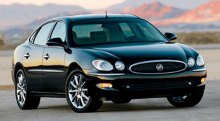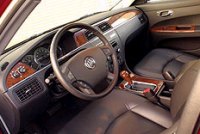Buick
LaCrosse (2004)
 When
General Motors is replacing both Buick Century and Regal with a single
model called "LaCrosse", even after the death of Oldsmobile Intrigue
(together
with the century-old brand), you know a lost of market share is
estimated.
The demand of American-style full-size sedans has been shrinking for
years,
mainly eaten by the Japanese (Lexus and Infiniti in particular) and
Sport
Utility Vehicles. However, there are still many old customers buying
such
cars every year. What they want are very simple - a lot of cabin space,
a comfortable ride, an affordable price and lastly, an American brand.
That's why GM decided not to spend too much money into the development
of LaCrosse. When
General Motors is replacing both Buick Century and Regal with a single
model called "LaCrosse", even after the death of Oldsmobile Intrigue
(together
with the century-old brand), you know a lost of market share is
estimated.
The demand of American-style full-size sedans has been shrinking for
years,
mainly eaten by the Japanese (Lexus and Infiniti in particular) and
Sport
Utility Vehicles. However, there are still many old customers buying
such
cars every year. What they want are very simple - a lot of cabin space,
a comfortable ride, an affordable price and lastly, an American brand.
That's why GM decided not to spend too much money into the development
of LaCrosse.
Apparently, the
easiest way
to save money is to design the LaCrosse based on its predecessors. That
means it also share the W-platform with Pontiac Grand Prix, Chevrolet
Impala
and Monte Carlo. All-strut suspensions are not anything to be proud of
for such a big car, but it guarantees low production cost, which
translates
to a significant price advantage over Japanese saloons. Moreover, it is
reasonably stiff and quiet, thanks partly to a new aluminum front
subframe.
Measuring over 5
meters in
length and have a 2807mm wheelbase, LaCrosse is able to sit 5 big guys
in comfort. Moreover, being a front-drive machine its rear seat is not
obstructed by transmission tunnel. Predictably, the cabin design is
conservative
to please the old people who buy it. Fake wood and so-so quality
plastics
might be an improvement over Century and Regal, but fall short behind
its
foreign competitors. Again, cost control is the driving force behind
that.
 LaCrosse
offers a couple of V6 engines. One of them is the familiar 3.8-litre
push-rod
engine. Now updated to Series III, it complies with the latest emission
standard and received a new intake manifold to reduce induction noise,
but its uninspiring manner remains unchanged. The iron-block engine
produces
just 200 horsepower, translating to a low power to weight ratio rarely
seen today. The only good news is that Series III will be the last
evolution
of the push-rod V6. GM will replace it with multi-valver eventually. LaCrosse
offers a couple of V6 engines. One of them is the familiar 3.8-litre
push-rod
engine. Now updated to Series III, it complies with the latest emission
standard and received a new intake manifold to reduce induction noise,
but its uninspiring manner remains unchanged. The iron-block engine
produces
just 200 horsepower, translating to a low power to weight ratio rarely
seen today. The only good news is that Series III will be the last
evolution
of the push-rod V6. GM will replace it with multi-valver eventually.
Another engine is
a cheapened
version of Holden / Cadillac's 3.6-litre dohc 24-valve V6. This is a
world-class
engine, featuring variable valve timing at all 4 camshafts. What a pity
in the Buick application it is detuned to 240hp and 225lbft, while
Cadillac
CTS 3.6 provides 255hp and 250lbft. The peak torque is actually no more
than the push-rod V6, therefore performance is just average, especially
it is mated with a lazy 4-speed automatic. However, the multi-valve V6
is definitely a more lovely choice than the Series III V6, as it revs
cleanly
towards 6000rpm and sounds much more eager.
The "updated"
chassis is
not really so updated. It still employs very soft springs and dampers
compare
with foreign saloons. Yes, the setup is already sportier than Century
and
Regal, body movement is now better controlled, but you know Century and
Regal were never famous of handling. Like them, LaCrosse is tuned to
please
customers in their 50s and 60s. Their sore backs need a supple ride to
take care. Don't talk about driving fun to them.
Externally,
LaCrosse looks
every bit a modernized saloon. However, underneath the skin is actually
very conservative and outdated. Chrysler 300 and Ford 500 will give it
a hard time, so are many Japanese saloons. Buick had better hope it has
enough loyal customers.
|